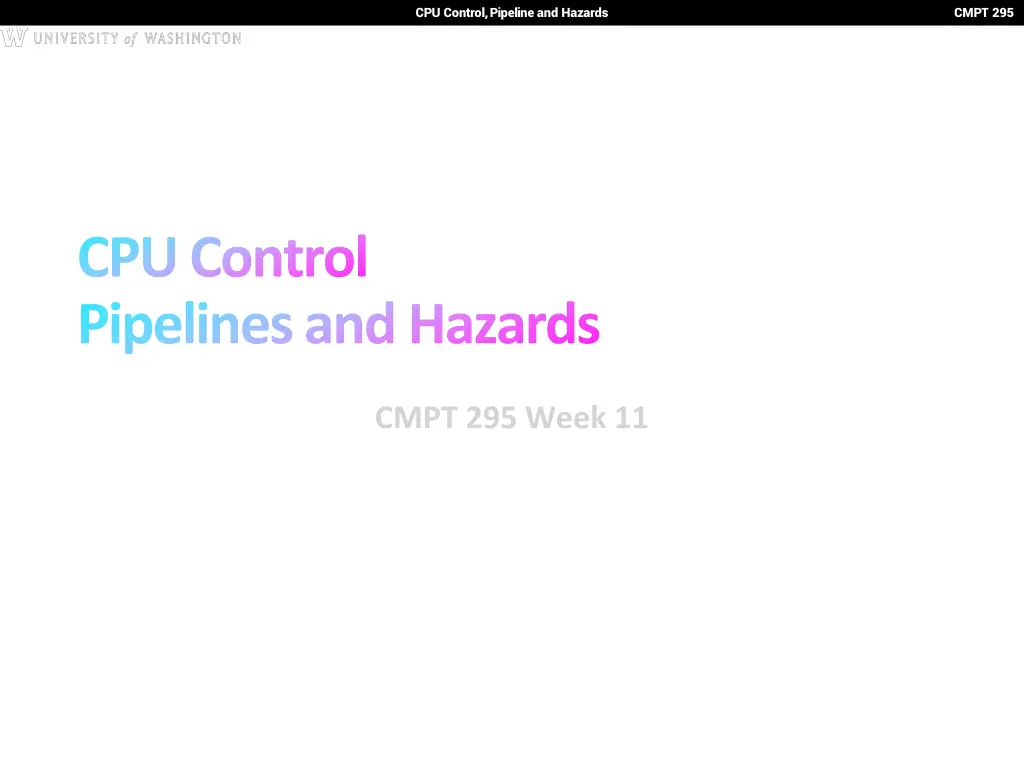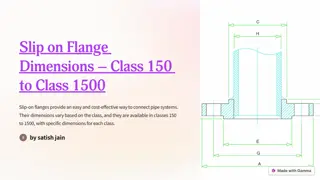
CPU Control, Pipeline, and Hazards in CMPT 295
Explore the concept of CPU control signals and how they influence hardware behavior and instruction execution in the context of pipelines and hazards. Learn about the sub-circuits based on instruction formats and the compilation of control signals for various instructions. Dive into the datapaths for ADD, addi, and lw instructions, understanding the role of different control signals in the CPU architecture.
Download Presentation

Please find below an Image/Link to download the presentation.
The content on the website is provided AS IS for your information and personal use only. It may not be sold, licensed, or shared on other websites without obtaining consent from the author. If you encounter any issues during the download, it is possible that the publisher has removed the file from their server.
You are allowed to download the files provided on this website for personal or commercial use, subject to the condition that they are used lawfully. All files are the property of their respective owners.
The content on the website is provided AS IS for your information and personal use only. It may not be sold, licensed, or shared on other websites without obtaining consent from the author.
E N D
Presentation Transcript
CPU Control, Pipeline and Hazards CMPT 295 CPU Control Pipelines and Hazards CMPT 295 Week 11
CPU Control, Pipeline and Hazards CMPT 295 Control Signals Control signals are how we get the same hardware to behave differently and execute different instructions For every instruction, all control signals are set to one of their possible values (not always 0 or 1) or an indeterminate (*) value indicating the control signal doesn t affect the instruction s execution Each control signal has a sub-circuit based on ~9 bits from the instruction format: Upper 5 func7 bits (lower 2 are the same for all instructions) All func3 bits 2nd upper opcode bit (others are the same for all instructions) 2
CPU Control, Pipeline and Hazards CMPT 295 Control Signals: ADD pc+4 +4 Reg[] pc alu wb 1 DataD 2 ALU Reg[rs1] 1 DMEM alu 0 pc 1 inst[11:7] IMEM AddrD 0 Addr wb Reg[rs2] pc+4 DataR Branch Comp. 0 0 inst[19:15] AddrA DataA DataW mem 1 inst[24:20] AddrB DataB inst[31:7] Imm. Gen imm[31:0] inst[31:0] PCSel ImmSel RegWEn BrUnBrEq BrLT BSel ASel ALUSel MemRW WBSel 3
CPU Control, Pipeline and Hazards CMPT 295 ADD: Control Signals Here are the signals and values we ve compiled for our ADD instruction: Inst[31:0] BrEq BrLT PCSel ImmSel BrUn ASel BSel ALUSel MemRW RegWEn WBSel * * +4 * * Reg Reg Add Read 1 (Y) ALU add (green = left 3 cols = control INPUTS) (orange = right 9 cols = control OUTPUTS) 4
CPU Control, Pipeline and Hazards CMPT 295 addi datapath pc+4 +4 Reg[] pc alu wb 1 DataD 2 ALU Reg[rs1] 1 DMEM alu 0 pc 1 inst[11:7] IMEM AddrD 0 Addr wb Reg[rs2] pc+4 DataR Branch Comp. 0 0 inst[19:15] AddrA DataA DataW mem 1 inst[24:20] AddrB DataB inst[31:7] Imm. Gen imm[31:0] inst[31:0] PCSel ImmSel RegWEn BrUnBrEq BrLT BSel ASel ALUSel MemRW WBSel Control Logic Inst[31:0] PCSel ImmSel RegWEn Br Un * Br LT * Br Eq * BSel ASel ALUSel MemRW WBSel +4 I 1 Imm Reg Add Read ALU addi 5
CPU Control, Pipeline and Hazards CMPT 295 lw datapath pc+4 +4 Reg[] pc alu wb 1 DataD 2 ALU Reg[rs1] 1 DMEM alu 0 pc 1 inst[11:7] IMEM AddrD 0 Addr wb Reg[rs2] pc+4 DataR Branch Comp. 0 0 inst[19:15] AddrA DataA DataW mem 1 inst[24:20] AddrB DataB inst[31:7] Imm. Gen imm[31:0] inst[31:0] PCSel ImmSel RegWEn BrUnBrEq BrLT BSel ASel ALUSel MemRW WBSel Inst[31:0] PCSel ImmSel RegWEn Br Un * Br Eq * Br LT * BSel ASel ALUSel MemRW WBSel +4 I 1 Imm Reg Add Read Mem lw 6
CPU Control, Pipeline and Hazards CMPT 295 Br datapath pc+4 +4 Reg[] pc alu wb 1 DataD 2 ALU Reg[rs1] 1 DMEM alu 0 pc 1 inst[11:7] IMEM AddrD 0 Addr wb Reg[rs2] pc+4 DataR Branch Comp. 0 0 inst[19:15] AddrA DataA DataW mem 1 inst[24:20] AddrB DataB inst[31:7] Imm. Gen imm[31:0] inst[31:0] PCSel ImmSel RegWEn BrUnBrEq BrLT BSel ASel ALUSel MemRW WBSel Inst[31:0] PCSel ImmSel RegWEn BrUn BrEq BrLT BSel ASel ALUSel MemRW WBSel +4 B 0 * 0 * Imm PC Add Read * beq ALU B 0 * 1 * Imm PC Add Read * beq 7
CPU Control, Pipeline and Hazards CMPT 295 jal datapath pc+4 +4 Reg[] pc alu wb 1 DataD 2 ALU Reg[rs1] 1 DMEM alu 0 pc 1 inst[11:7] IMEM AddrD 0 Addr wb Reg[rs2] pc+4 DataR Branch Comp. 0 0 inst[19:15] AddrA DataA DataW mem 1 inst[24:20] AddrB DataB inst[31:7] Imm. Gen imm[31:0] inst[31:0] PCSel ImmSel RegWEn BrUnBrEq BrLT BSel ASel ALUSel MemRW WBSel Inst[31:0] PCSel ImmSel RegWEn Br Un * Br Eq * BrLT BSel ASel ALUSel MemRW WBSel ALU J 1 * Imm PC Add Read PC+4 jal 8
CPU Control, Pipeline and Hazards CMPT 295 Inst[31:0] PCSel ImmSel RegWEn Br Un * Br Eq * Br LT * BSel ASel ALUSe l Reg MemRW WBSel +4 * 1 (Y) Reg Add Read ALU add +4 * 1 * * * Reg Reg Sub Read ALU sub +4 * 1 * * * Reg Reg (Op) Read ALU (R-R Op) +4 I 1 * * * Imm Reg Add Read ALU addi +4 I 1 * * * Imm Reg Add Read Mem lw +4 S 0 (N) * * * Imm Reg Add Write * sw +4 B 0 * 0 * Imm PC Add Read * beq ALU B 0 * 1 * Imm PC Add Read * beq ALU B 0 * 0 * Imm PC Add Read * bne +4 B 0 * 1 * Imm PC Add Read * bne ALU B 0 0 * 1 Imm PC Add Read * blt ALU B 0 1 * 1 Imm PC Add Read * bltu ALU I 1 * * * Imm Reg Add Read PC+4 jalr ALU J 1 * * * Imm PC Add Read PC+4 jal +4 U 1 * * * Imm PC Add Read ALU auipc 9
CPU Control, Pipeline and Hazards CMPT 295 Instruction Timing IF ID EX MEM WB Total IMEM Reg Read ALU DMEM Reg W 200 ps 100 ps 200 ps 200 ps 100 ps 800 ps 10
CPU Control, Pipeline and Hazards CMPT 295 Instruction Timing Instr add beq jal lw sw IF = 200ps X X X X X ID = 100ps X X X X X ALU = 200ps X X X X X MEM=200ps WB = 100ps X Total 600ps 500ps 600ps 800ps 700ps X X X X Maximum clock frequency fmax = 1/800ps = 1.25 GHz Most blocks idle most of the time. For example, IF active every 200/800ps Instruction 1 Instruction 2 IF ID ALU MEM WB IF ID ALU MEM WB Clk
CPU Control, Pipeline and Hazards CMPT 295 Iron Law of Processor Performance Time = Instructions Program Program * Instruction * Cycle Cycles Time 12
CPU Control, Pipeline and Hazards CMPT 295 Speed Trade-off Example For some task (e.g., image compression) Processor A 1 Million 2.5 2.5 GHz 1 ms Processor B 1.5 Million 1 2 GHz 0.75 ms # Instructions Average CPI Clock rate f Execution time Processor B is faster for this task, despite executing more instructions and having a lower clock rate. Why? Each instruction is less complex (~2.5 B instructions = 1 A instruction) 13
CPU Control, Pipeline and Hazards CMPT 295 Improving Processor Performance with Pipelining
CPU Control, Pipeline and Hazards CMPT 295 Pipelined Car Assembly Line 6 AM 7 8 10 11 9 12 Time Car 1 Station 1 Station 2 Station 3 Station 4 Car 2 Station 1 Station 2 Station 3 Station 4 Car 3 Station 1 Station 2 Station 3 Station 4 Station 1 Station 2 Station 3 Station 4 Car 4 Pipelined Car assembly takes 7 hours for 4 cars 1 car finishes every hour (after the first car, which takes 4 hours) 15
CPU Control, Pipeline and Hazards CMPT 295 Pipelining Lessons Pipelining doesn t decrease latency of single task; it increases throughput of entire workload Multiple tasks operating simultaneously using different resources Potential speedup ~ number of pipeline stages Speedup reduced by time to fill and drain the pipeline: 16 hours/7 hours which gives 2.3X speedup v. potential 4X in this example Pipeline frequency depends on longest pipeline stage 16
CPU Control, Pipeline and Hazards CMPT 295 Pipelining with RISC-V tinstruction instruction sequence add t0, t1, t2 or t3, t4, t5 Longest pipeline stage sll t6, t0, t3 tcycle Single Cycle Pipelining tcycle = 200 ps All cycles same length 5 x tcycle =1000 ps 1/200 ps = 5 GHz Timing tstep= 200,100,200,200,100 ps Register access only 100 ps = tcycle = 800 ps 1/800 ps = 1.25 GHz Instruction time, tinstruction Clock rate, fs 17
CPU Control, Pipeline and Hazards CMPT 295 RISC-V Pipeline tinstruction = 1000 ps Resource use in a particular time slot add t0, t1, t2 Resource use by instruction over time or t3, t4, t5 instruction sequence slt t6, t0, t3 sw t0, 4(t3) lw t0, 8(t3) tcycle = 200 ps addi t2, t2, 1 18
CPU Control, Pipeline and Hazards CMPT 295 Each stage operates on different instruction add t0, t1, t2 lw t0, 8(t3) sw t0, 4(t3) slt t6, t0, t3 or t3, t4, t5 pcM pcX pcF pcD +4 +4 Reg[] rs1X DataD ALU 1 DMEM aluX AddrD 0 Addr aluM DataR Branch Comp. pcF+4 IMEM DataA AddrA DataW DataB AddrB instD rs2M rs2X immX Imm. instX instM instW Pipeline registers separate stages, hold data for each instruction in flight 19
CPU Control, Pipeline and Hazards CMPT 295 RISC-V Pipeline Example Address 0x00 0x04 0x08 0x0C Inst | Cycle add a1,a2,a3 addi a4,a5,0x2f7 sub s4,s0,s3 or s1,s2,s5 0 IF 1 ID IF 2 3 4 5 6 7 EX ID IF MEM EX ID IF WB MEM EX ID WB MEM EX WB MEM WB 20
CPU Control, Pipeline and Hazards CMPT 295 Instruction Level Parallelism (ILP) Pipelining allows us to execute parts of multiple instructions at the same time using the same hardware! This is known as instruction level parallelism Later: Other types of parallelism DLP: same operation on lots of data (SIMD) TLP: executing multiple threads simultaneously (e.g., using OpenMP or pthreads) 21
Question: Assume the stage times shown below. Suppose we remove loads and stores from our ISA. Consider going from a single-cycle implementation to a 4-stage pipelined version. Instr Fetch 200ps Reg Read ALU Op Mem Access Reg Write 100 ps 200ps 200ps 100 ps 1) 2) The latency will be ?x slower. The throughput will be ?x higher. No mem access Throughput: Old: one inst every (IF+ID+EX+WB) = 600 ps New: one inst every (4*max_stage)/4 = 200 ps New/Old throughput = (1/200)/(1/600) = 3x higher 22
Question: Assume the stage times shown below. Suppose we remove loads and stores from our ISA. Consider going from a single-cycle implementation to a 4-stage pipelined version. Instr Fetch 200ps The latency will be ?x slower. The throughput will be 3x higher. Reg Read ALU Op Mem Access Reg Write 100 ps 200ps 200ps 100 ps 1) 2) No mem access Latency (per inst): Old latency: IF+ID+EX+WB = 600 ps New latency = 4*max_stage = 800 ps New/Old = 800/600 = 1.33x slower 23
Question: Assume the stage times shown below. Suppose we remove loads and stores from our ISA. Consider going from a single-cycle implementation to a 4-stage pipelined version. Instr Fetch 200ps Reg Read ALU Op Mem Access Reg Write 100 ps 200ps 200ps 100 ps 1) 2) The latency will be 1.33x slower. The throughput will be 3x higher. 24
CPU Control, Pipeline and Hazards CMPT 295 Hazards Ahead! Agenda RISC-V Pipeline Hazards Structural Data R-type instructions Load Control Superscalar processors 25
CPU Control, Pipeline and Hazards Pipeline Hazards CMPT 295 A hazard is a situation that prevents starting the next instruction in the next clock cycle 1) Structural hazard A required resource is busy (e.g. needed in multiple stages) 2) Data hazard Data dependency between instructions Need to wait for previous instruction to complete its data write 3) Control hazard Flow of execution depends on previous instruction 26
CPU Control, Pipeline and Hazards CMPT 295 Structural Hazard: Regfile! RegFile: Used in ID and WB! Time (clock cycles) I n s t r Load Add Store O r d e r Sub Or 27
CPU Control, Pipeline and Hazards CMPT 295 RISC-V Pipeline: Regfile Structural Hazard Addr 0x00 0x04 0x08 0x0C addi a3, a6, 5 Inst | Cycle addi a0, zero, 5 addi a1, a4, 5 addi a2, a5, 5 0 IF 1 ID IF 2 3 4 5 6 7 8 9 10 EX ID IF MM WB EX ID IF MM WB EX ID MM WB ID EX MM WB 28
CPU Control, Pipeline and Hazards CMPT 295 Regfile Structural Hazards Each instruction: Can read up to two operands in decode stage Can write one value in writeback stage Avoid structural hazard by having separate ports Two independent read ports and one independent write port Three accesses per cycle can happen simultaneously RW RA RB Write Enable 5 5 5 portA portW 32 32 32 x 32-bit Registers portB Clk 32 29
CPU Control, Pipeline and Hazards CMPT 295 Regfile Structural Hazards Two alternate solutions: 1) Build RegFile with independent read and write ports; good for single-stage 2) Double Pumping: Split RegFile access in two. Prepare to write during 1st half, write on rising edge, read during 2nd half of each clock cycle (falling edge) Will save us a cycle later... Possible because RegFile access is fast (takes less than half the time of ALU stage) Conclusion: It is OK to read and Write to registers during same clock cycle 30
CPU Control, Pipeline and Hazards CMPT 295 Regfile Structural Hazard: 2 Rd+1Wr Ports Addr 0x00 0x04 0x08 0x0C addi a3, a6, 5 Inst | Cycle addi a0, zero, 5 addi a1, a4, 5 addi a2, a5, 5 0 IF 1 ID IF 2 3 4 5 6 7 8 9 10 EX ID IF MM WB EX ID IF MM WB EX ID MM WB EX MM WB 31
CPU Control, Pipeline and Hazards CMPT 295 Structural Hazard: Memory Access Instruction and data memory used simultaneously Use two separate memories add t0, t1, t2 or t3, t4, t5 instruction sequence slt t6, t0, t3 sw t0, 4(t3) lw t0, 8(t3) 32
CPU Control, Pipeline and Hazards CMPT 295 Structural Hazards Summary Conflict for use of a resource In RISC-V pipeline with a single memory unit Load/store requires data access Without separate memory units, instruction fetch would have to stall for that cycle All other operations in pipeline would have to wait Pipelined datapaths require separate instruction/data memory units Or separate instruction/data caches RISC ISAs (including RISC-V) designed to avoid structural hazards e.g. at most one memory access/instruction 33
CPU Control, Pipeline and Hazards CMPT 295 2. Data Hazards (1/2) Consider the following sequence of instructions: add s0, s1, s2 sub s4, s0, s3 and s5, s0, s6 or s7, s0, s8 xor s9, s0, s10 Read during ID Stored during WB 34
CPU Control, Pipeline and Hazards CMPT 295 2. Data Hazards (2/2) Identifying data hazards: - Where is data WRITTEN? - Where is data READ? - Does the WRITE happen AFTER the READ? Time (clock cycles) add s0, s1, s2 sub s4, s0, s3 and s5, s0, s6 or s7, s0, s8 xor s9, s0, s10 35
CPU Control, Pipeline and Hazards CMPT 295 Solution 1: Stalling Problem: Instruction depends on result from previous instruction add s0, s1, s2 sub s4, s0, s3 add s0, s1, s2 sub s4, s0, s3 Bubble: effectively NOP: affected pipeline stages do nothing (add x0 x0 x0)
CPU Control, Pipeline and Hazards CMPT 295 Data Hazard Addr 0x00 0x04 0x08 0x0C Inst | Cycle 0 IF 1 ID IF 2 3 4 5 6 7 8 9 10 EX ID IF MM WB - - add s0, s1, s2 - - EX ID IF MM WB EX ID sub s4, s0, s3 MM WB EX and s5, s0, s6 MM WB or s7, s0, s8 37
CPU Control, Pipeline and Hazards CMPT 295 Data Hazard Solution: Forwarding Forward result as soon as it is available, even though it s not stored in RegFile yet add s0, s1, s2 sub s4, s0, s3 and s5, s0, s6 or s7, s0, s8 xor s9, s0, s10 Forwarding: get operand from pipeline stage, rather than register file 38
CPU Control, Pipeline and Hazards CMPT 295 Data Hazard with Forwarding Addr 0x00 0x04 0x08 0x0C Inst | Cycle 0 IF 1 ID IF 2 3 4 5 6 7 8 9 10 EX ID IF MM WB EX ID IF add s0, s1, s2 MM WB EX ID sub s4, s0, s3 MM WB EX and s5, s0, s6 MM WB or s7, s0, s8 39
CPU Control, Pipeline and Hazards CMPT 295 Data Hazard: Loads (1/2) Recall: Dataflow backwards in time are hazards lw t0, 0(t1) sub t3, t0, t2 Can t solve all cases with forwarding Must stall instruction dependent on load (sub), then forward after the load is done (more hardware) 40
CPU Control, Pipeline and Hazards CMPT 295 Data Hazard: Loads (2/2) Slot after a load is called a load delay slot If that instruction uses the result of the load, then the hardware will stall for one cycle Equivalent to inserting an explicit nop in the slot except the latter uses more code space Performance loss Idea: Let the compiler/assembler put an unrelated instruction in that slot no stall! 41
CPU Control, Pipeline and Hazards CMPT 295 3. Control Hazards Branch (beq, bne,...) determines flow of control Fetching next instruction depends on branch outcome Pipeline can t always fetch correct instruction Result isn t known until end of execute Simple Solution: Stall or flush on every branch until we have the new PC value How long must we stall? 42
CPU Control, Pipeline and Hazards CMPT 295 How many instructions after beq are affected by the control hazard? beq A)1 B) 2 C) 3 D)4 E) 5 Instr 1 Instr 2 Instr 3 Instr 4 43
CPU Control, Pipeline and Hazards CMPT 295 Branch Stall How many bubbles required for branch? Time (clock cycles) beq Instr 1 Instr 2 Instr 3 Instr 4 44
CPU Control, Pipeline and Hazards CMPT 295 Taken Branch & ecall 45
CPU Control, Pipeline and Hazards CMPT 295 Not-Taken Branch 46
CPU Control, Pipeline and Hazards CMPT 295 3. Control Hazard: Branching RISC-V Solution: Branch Prediction guess outcome of a branch, fix afterwards if necessary Must cancel (flush) all instructions in pipeline that depended on guess that was wrong How many instructions do we end up flushing? 47
CPU Control, Pipeline and Hazards CMPT 295 Clear Instructions after Branch if Taken Taken branch beq t0, t1, label Convert to NOP sub t2, s0, t5 Convert to NOP or t6, s0, t3 PC updated reflecting branch outcome label: xxxxxx Two instructions are affected by an incorrect branch, just like we d have to insert two NOP s/stalls in the pipeline to wait on the correct value! 48
CPU Control, Pipeline and Hazards CMPT 295 Branch Prediction Taken branch beq t0, t1, label Guess next PC! label: .. .. Check guess correct In the correct case, we don t have any stalls/NOP s at all! Prediction, if done correctly, is better on average than stalling 49






















